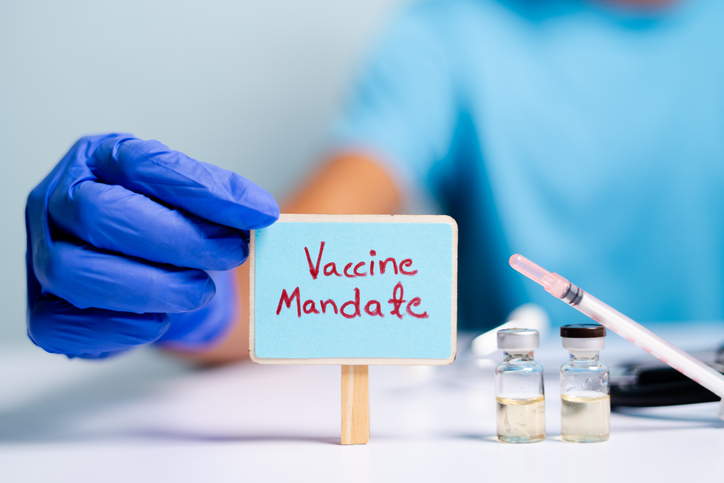OSHA Orders Employers to Adopt Mandatory COVID-19 Vaccination or Testing Policies

On November 4, 2021, the federal Occupational Safety and Health Administration (OSHA) issued a new Emergency Temporary Standard (ETS), requiring employers with over 100 employees to implement a mandatory COVID vaccination policy, or alternatively a policy requiring employees either to be vaccinated or be tested weekly and be masked in the workplace.
Employers must comply by December 5, 2021. We summarize the ETS requirements below.
Who Is Covered
The ETS applies to all private employers with 100 or more employees, regardless of whether the employees are full- or part-time, temporary, or seasonal, unionized, or non-unionized. Employees employed by a staffing agency do not count toward the 100 employee threshold. However, staffing agencies are themselves covered when they have over 100 employees, regardless of location.
Excluded from ETS coverage are:
- federal contractor workplaces covered by Executive Order 14042;
- health care workplaces covered by the Healthcare ETS (29 C.F.R. § 1910.502); and
- public employers in states without OSHA-approved State Plans.
Although all employees are counted for purposes of ETS coverage, not all employees are required to comply with a covered employer’s written policy. The ETS does not apply to:
- Employees who do not report to a workplace where other individuals (such as coworkers or customers) are present;
- Employees who work from home; or
- Employees who work exclusively outdoors.
Vaccination Policy Requirement
No later than December 5, 2021, covered employers are required to develop and implement a mandatory COVID-19 vaccination policy. Under such a policy, employees must be fully vaccinated no later than January 4, 2022, meaning that at least two weeks have passed since the employee received the second dose of a two-dose vaccine (Moderna or Pfizer) or a dose of a single-dose vaccine (Johnson & Johnson). Prior infection does not count as being fully vaccinated. In addition, employers must make reasonable accommodations for employees who cannot obtain the vaccine due to medical reasons or sincerely held religious beliefs.
Employers may, as an alternative to a mandatory vaccination policy, choose to implement and enforce a policy allowing employees to choose to either get vaccinated or to submit to weekly testing and wear face covering while at work. For employers adopting such an “employee choice” policy, employees who are not fully vaccinated (including who have not completed the vaccination process at least two weeks earlier) will need to start undergoing testing (and masking) as of January 4, 2022.
Documentation and Recordkeeping
Employers are required to determine the vaccination status of employees and to obtain appropriate proof as to employee’s vaccination status. Permissible forms of proof of vaccination are:
- A record of immunization from a health care provider or pharmacy;
- A copy of the U.S. COVID-19 Vaccination Record Card;
- A copy of medical records documenting the vaccination;
- A copy of immunization records from a public health, state, or tribal immunization information system; or
- A copy of any other official documentation that contains the type of vaccine administered, date(s) of administration, and the name of the health care professional(s) or clinic site(s) administering the vaccine(s).
Employees who are not able to provide one of these forms of proof of vaccination may submit a sworn, written statement attesting to their vaccination status. Employers must keep a roster of each employee’s vaccination status, and as with all medical information, the information must be kept confidential and separate from an employee’s personnel file.
Vaccination Paid Leave
As part of its policy, employers must provide employees reasonable time, including up to four hours of paid time, to receive each dose of vaccination. This time is in addition to any paid sick or other leave available to the employer. In addition, employees must be permitted to use sick leave, paid time off, or other qualifying leave to recover from reactions associated with obtaining the vaccine. To the extent an employee does not have available sick leave or time off to recover from their vaccination, the employer must provide up to two days of paid leave for this purpose.
Removing Employees Infected with COVID-19
To prevent the spread of COVID-19, employers must remove from the workplace any employee who either tests positive for COVID-19 or is diagnosed as having COVID-19 by a licensed healthcare provider, regardless of vaccination status. Employees are required to report such test results or diagnoses to the employer. Employees may return to the workplace if they have tested negative for COVID-19, are informed by a licensed healthcare provider that they may return to work, or meet the CDC’s criteria for release for isolation.
Notices to Employees
Employers must provide employees with the written policy required by the ETS in a language and at a literacy level that employees can understand. Employers must also provide employees with copies of two OSHA publications, “Key Things to Know About COVID-19 Vaccines” (click here), and a notice about the penalties for falsifying records, available here.
Federal Preemption and Legal Challenges
The ETS preempts state laws that ban or limit an employer’s ability to require vaccination, face covering, or testing. Although effective as of November 4, 2021, the ETS is a proposed rule under Section 6(b) of the OSH Act. Thus, the ETS could change in the future.
On November 6, 2021, the Fifth Circuit Court of Appeals temporarily stayed the ETS in the face of legal challenges to its constitutionality. The stay is pending further briefing and is not a decision one way or the other as to the legality of the ETS. Employers should begin preparing to comply with the ETS, as we anticipate it will become effective in some fashion.
For more information, please reach out to Felicia Reid, freid@hkemploymentlaw.com, (415) 835-9024, or Jesse Sutz, jsutz@hkemploymentlaw.com, (415) 835-9017.





